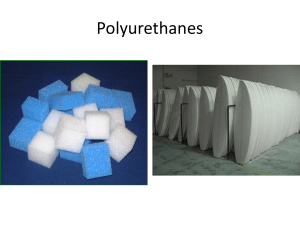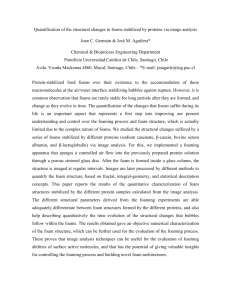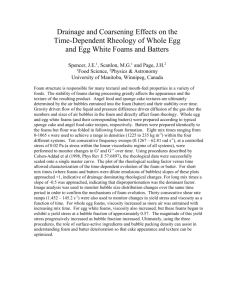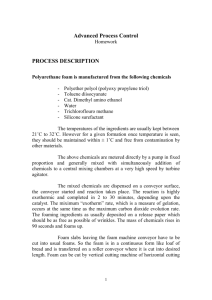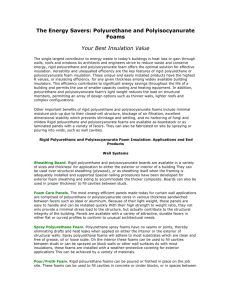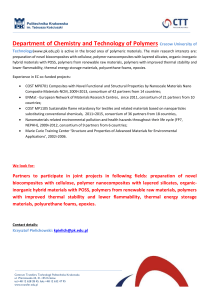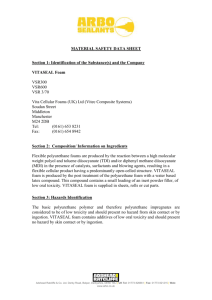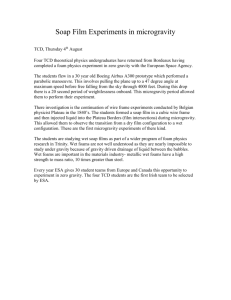POLYURETHANES
advertisement
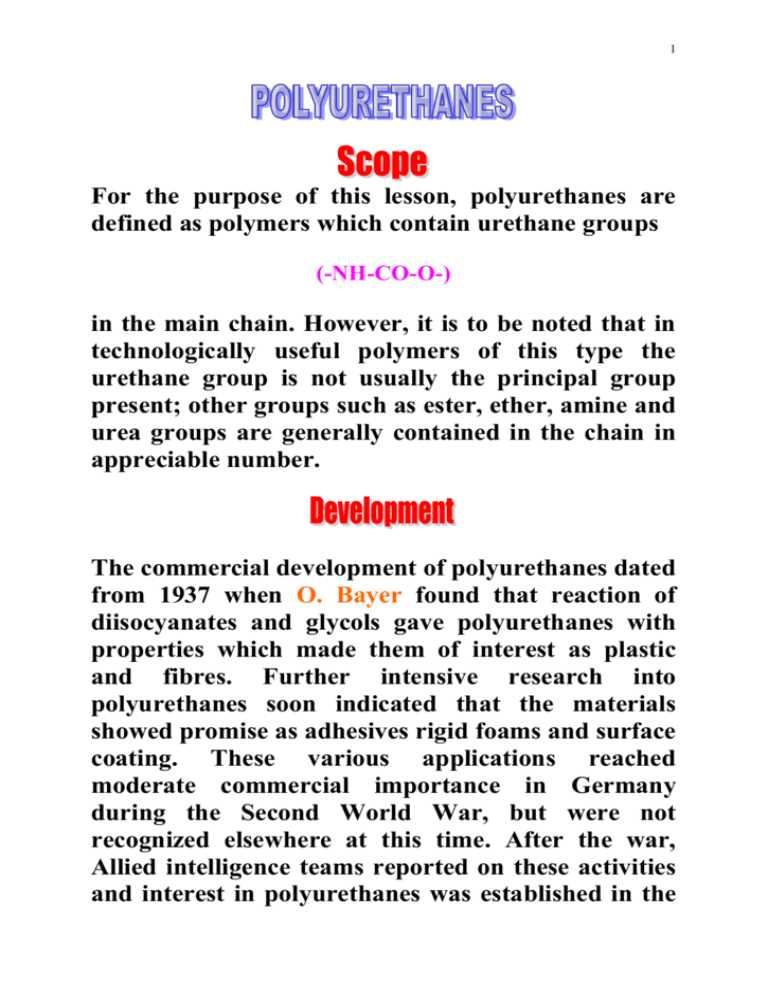
1 For the purpose of this lesson, polyurethanes are defined as polymers which contain urethane groups (-NH-CO-O-) in the main chain. However, it is to be noted that in technologically useful polymers of this type the urethane group is not usually the principal group present; other groups such as ester, ether, amine and urea groups are generally contained in the chain in appreciable number. The commercial development of polyurethanes dated from 1937 when O. Bayer found that reaction of diisocyanates and glycols gave polyurethanes with properties which made them of interest as plastic and fibres. Further intensive research into polyurethanes soon indicated that the materials showed promise as adhesives rigid foams and surface coating. These various applications reached moderate commercial importance in Germany during the Second World War, but were not recognized elsewhere at this time. After the war, Allied intelligence teams reported on these activities and interest in polyurethanes was established in the 2 U.K. and U.S.A. although commercial development was slow. The German chemical industry quickly recovered from the effects of war; Bayer again become active in the polyurethane field and developed elastomers (1950) and flexible foams (1952). In the period 1952- 54 this company developed its diisocyanate- polyester flexible foam system to a degree for commercial use and also introduced novel machines for continuous production of the foams. By 1955 the mass – production of polyester –based foams was established in the most industrial countries. The urethane group results from the interaction of an isocyanate and a hydroxyl compound. R-NCO + HO-R’ R-NH-CO-O-R’ It will be apparent that this reaction leads to polyurethanes when multifunctional reactants are used. When a diisocyanate and a diol react together a linear polyurethane is obtained whilst a diisocyanate and a polyhydric compound(polyol) lead to a cross-linked polymer. A cross-linked polyurethane could also be derived from a compound containing three or more isocyanate groups and a diol but this approach is of limited commercial importance. 3 Thus diisocyanates and diols and polyols are the principal raw materials used in the manufacture of polyurethanes. The more importance of these reactants are given below. Several reactions are known by which isocyanetes are formed. However, there is only one method of preparation of commertial importance, namely phosgenation of primary amines R’-NH2 + COCl2 R – N = C = O + 2 HCl Toluene is the starting material for the production of tolylene diisocyanate (TDI) and production process may varied to give products of different isomer contents end of the nitration; 4 5 Diphenylmethane diisocyanate (MDI) is derived from aniline, the principal reaction involved are as follows : Naphthylene 1,5-diisocyanate (NDI) is prepared from naphthalene as follows : Hexamethylene diisocyanate (HMI) is prepared by the phosgenation of hexamethylenediamine 6 COCl2 H2N-(CH2)6-NH2 OCN-(CH2)6-NCO The earliest polyurethanes were based on aliphatic diols (glycols) and, of the various glycols investigated, 1,4 butandiol was generally preferred for commercial operations. Since this time, however production of polyurethanes has mainly involved polymeric hydroxyl compounds. The use of these materials permits the manufacture of a much wider range products at relatively low cost. The polymeric hydroxyl compounds which have received most attention are polyesters and polyethers. 1,4 butandiol is prepared from acetylene by following route At one time this glycol was used to prepare fibre forming polyurethanes but its use in now limited mainly to molding materials and cast elastomers. 7 The polyesters used in the preparation of polyurethanes generally have molecular weight in the range 1000 -2000 and are liquids or low – melting solids ; they are usually saturated. The essential feature of these polyesters is that they are hydroxyl –terminated and thus hydroxyl groups are available to participate in the urethane reaction. Hydroxyl–terminated polyethers have now assumed a dominant role in the commertial production of polyurethanes the most widely used polyethers are derivatives of propylene oxide. A polyester : Poly(ethylene terephthalate)PET HO-CH2-CH2-O-[(O-C-Ph-CO-O-CH2-CH2-O)-H A polyether : Poly(ethylene oxide )PEO HO-[-CH2-CH2-O-]-CH2-CH2-OH 8 Isocyanates are very reactive materials and undergo a great many reactions. In this section, those reactions which have technological significance are discussed. The common reactions of isocyanates may be divided into two classes, namely addition reactions with compounds containing active hydrogen and self addition. The more important reactions involving active hydrogen compounds are shown below 9 R-NCO + R’-OH R-NH-CO-O-R’ a Urethane R-NCO + R’-NH2 R-NH-CO-NH-R’ a urea R-NCO + R’-COOH Reaction(v) Reaction (vi) [R-NH-CO-O-CO-R’] Anhydride -CO2 R-NH-CO-R’ amine R-NCO + H2O Reaction (vii) [R-NH-COOH] a carbamic acid -CO2 R-NH2 Reaction (ii) R’ R-NCO + R’-NH-CO-O-R’’ R-NH-CO-N-CO-O-R’’ allophanate 10 R’ R-NCO + R’-NH-CO-NH-R’ R-NH-CO-N-CO-NH-R’’ biuret R’ R-NCO + R’-NH-CO-R’’ R-NCO + HO-Ph R-NH-CO-N-CO-R’’ acylurea R-NH-CO-O-Ph a urethane 11 Polyurethane foams are produced by forming a Polyurethane polymer concurrently with a gas evolution process. Provided these two processes are balanced bubbles of gas are trapped in the polymer matrix as it is formed and a cellular product results. The gas used in the production of flexible foams is usually carbondioxide formed by the interaction of isocyanate and water. In the system containing a diisocyanate, a polyol and water, two principal reaction proceed simultaneously, namely : Diisocyanate + polyol polyurethane Diisocyanate + water carbondioxide As indicated above, a satisfactory foam is obtained only if these two reaction are in step Polyether foams Flexible polyether foams are most commonly produced by a “one-shot” process In this procedure, diisocyanate, polyol, water, catalysts and surfactant are all mixed simultaneously. After 1-2 minutes the foam reaches its maximum height. 12 A typical formulation for flexible polyether foam would be as follows; Polyether triol 80:20 Tolylene diisocyanate Water Triethylenediamine Stannous octoate Silicone block copolymer : 100 parts by weight : 40 : 3.0 : 0.5 : 0.3 : 1.0 Polyester foams Flexible polyester foams are nearly always prepared by a one-shot process; most commonly they are produced as slabstock by a continuous method exactly comparable to that described previously for polyether foam. A typical formulation for flexible polyester foam would be as follows; Polyester(slightly branched) 65:35 Tolylene diisocyanate Water N-methylmorpholine N,N Dimethylcetylamine Ammonium oleate : 100 parts by weight : 33 : 4.0 : 2.0 : 2.0 : 2.0(surfactant) 13 Flexible polyurethane foams are open-cell structure which are usally produced with densities in the range 1.5-3 lb/ft3 Typical load deflection curves for polyether and polyester foams are shown below. Compared to polyether foams, polyester foams have higher tensile strength, elongation at break and hardness; consequently polyester foams are preferred in such applications as textile laminates and coat shoulder pads Polyurethane foams are resistant to a wide range of solvents. In this respect polyester foams are generally superior to polyether foams, particularly in resistance to dry cleaning solvents; in this further reason for preferring polyester foams in textile applications. 14 Polyurethane foams are subject to degradation by aqueous acids and alkalis and steam. Ester, amine and urethane groups represent sites for hydrolytic attack. Since the ether groups not ready attacked polyether foams are generally more resistant to hydrolysis than polyester foams. The principle underlying the production of rigid polyurethane foams is fundamentally the same as that used for flexible foams, namely a reacting isocyanate/polyol mixture is simultaneously expanded by gas generation. The essential difference between the two products lies in their degree of cross-linking; whereas flexible foams are lightly cross-linked, rigid foams are highly cross-linked. This high degree of cross-linking is achieved by using relatively low molecular weight polyols for coupling with the isocyanate. A typical basic formulation for rigid polyether foam might be as follows ; Polyether polyol Crude diphenylmethane diisocyanate Trichlorofloromethane Triethyleneamine Silicone block copolymer Glycerol : 100 parts by weight : Stoichiometric +5% : 50 : 0.5 : 1.0 :10(cross-linking) 15 Rigid polyurethane foams are closed-cell structures which are usually produced with a density of about 2 lb /ft3. Since the major interest in rigid foams has been for thermal insulation, the thermal conductivity of the foams is a physical property of some importance. The chemical properties of rigid polyurethane foams are similar to those of flexible foams. Solid polyurethane elastomers (as distinct from flexible foams) may be divided into three categories, namely * cast, * millable and * thermoplastic elastomers. Cast elastomers In the casting technique a liquid reaction mixture comprising low molecular weight material is poured into a heated mould, where the material is converted to a solid, high molecular weight elastomeric product. 16 The reactions which occur when a glycol is used in the above operation are not fully understood, but it is thought that firstly the glycol react with the isocyanate-terminated propolymer to give an extended polymer containing glycol-urethane links. The amount of glycol used is slightly less than that required to react with all the isocyanate in the pre-polymer and so the extended polymer is isocyanete terminated; the situation may be illustrated as follows : 17 The extended polymer is generally supposed to cross-link through reaction of terminal isocyanete groups with urethane groups in the polymer chain with the formation of ALLOPHANATE links Cross-linking may also occur through trimerization of terminal isocyanate groups to isocyanurate The reaction involved when a diamine is used in the preparation of a cast elastomer are more apparent. The amine and pre-polymer react to give an extended polymer containing urea groups 18 which then form BIURET cross-link by reaction with terminal isocyanete groups. Millable elastomers A disadvantage of the cast elastomers described in the previous section is that the isocyanateterminated pre-polymer have limited shelf-life and must be stored in the absence of moisture. Further the practical procedures involved are very different from those generally associated with synthetic rubbers. These factors led to the development of polyurethane elastomers to which the conventional techniques of mill compounding and vulcanization can be applied. 19 In this approach, stable (hydroxyl- terminated) polymers are prepared by the reaction of lineer polyesters(commonly adipates) or polyesters (commonly poly(oxytetramethylene) glycol) with diisocyanete. These polymers are rubber like gums which may be compounded on the two-roll mills with other ingradients, sulphur systems and peroxides are the most widely used. Reaction of the urea and amine groups with a diisocyanete leads to the formation of BIURET and ACYLUREA cross-link respectively Thermoplastic Elastomers Thermoplastic Elastomers are materials which process, at normal temperatures the characteristics resilience and recovery from extension of cross-linked elastomers but which exhibit plastic flow at elevated temperatures and can be fabricated by the usual techniques applied to thermoplastics, e.g. injection moulding and extrusion. These effects are associated with linear polymers containing segments which give rise to interchain secondary valency forces of polar attractions. At normal temperature, these interactions have the effect of conventional covalent cross-links but a elevated temperatures 20 the secondary bonds dissociate and the polymer exhibits thermoplastic behavior. Surface coating Several polyurethane-type products are utilized in coating applications by Air curing System Moisture-curing system Head Curing system Adhesives Several polyurethane-type products are used as adhesives. These general categories may be distinguished namely isocyanete-polyol systems, soluble elastomers and polyisocyanetes The adhesive properties of the foregoing materials may be attributed to the polar nature of the polymers involved. Further, the isocyanates present in the compositions may react with any active hydrogen present in the substrate or with the films of water which are often present on the surface of such materials as ceramics, glass and metals.
